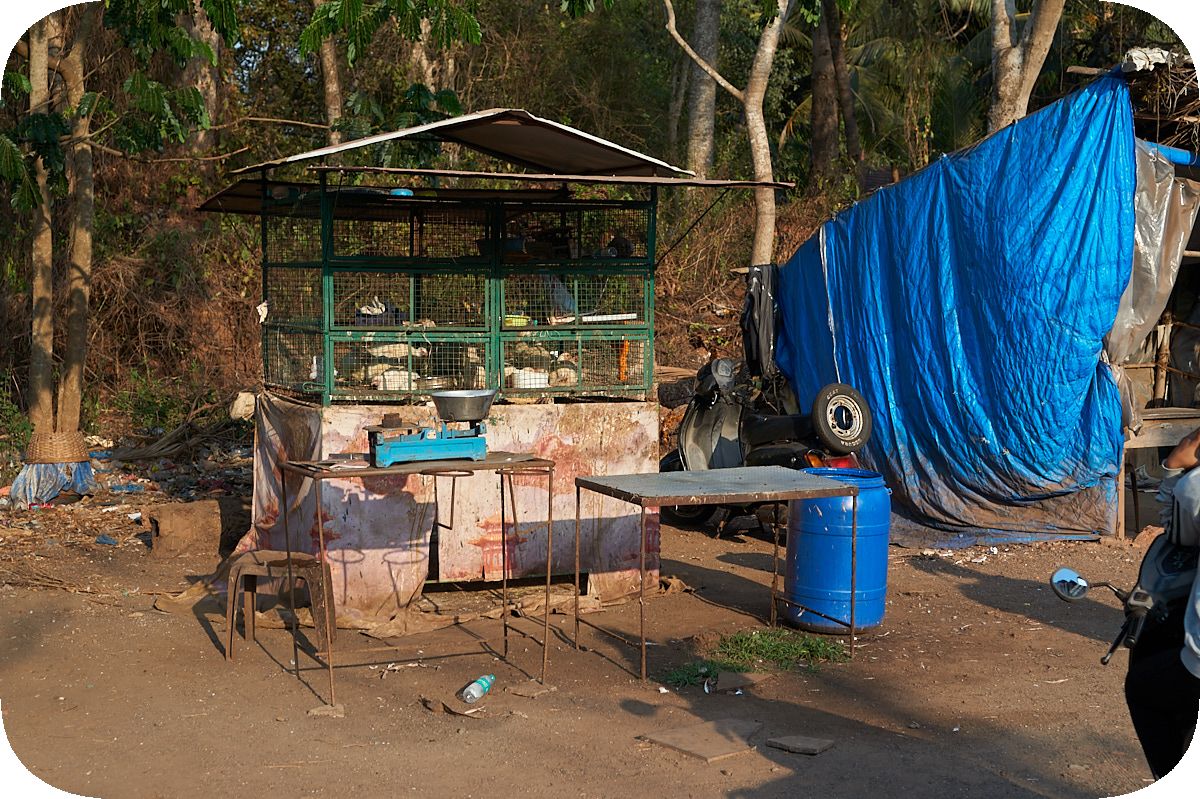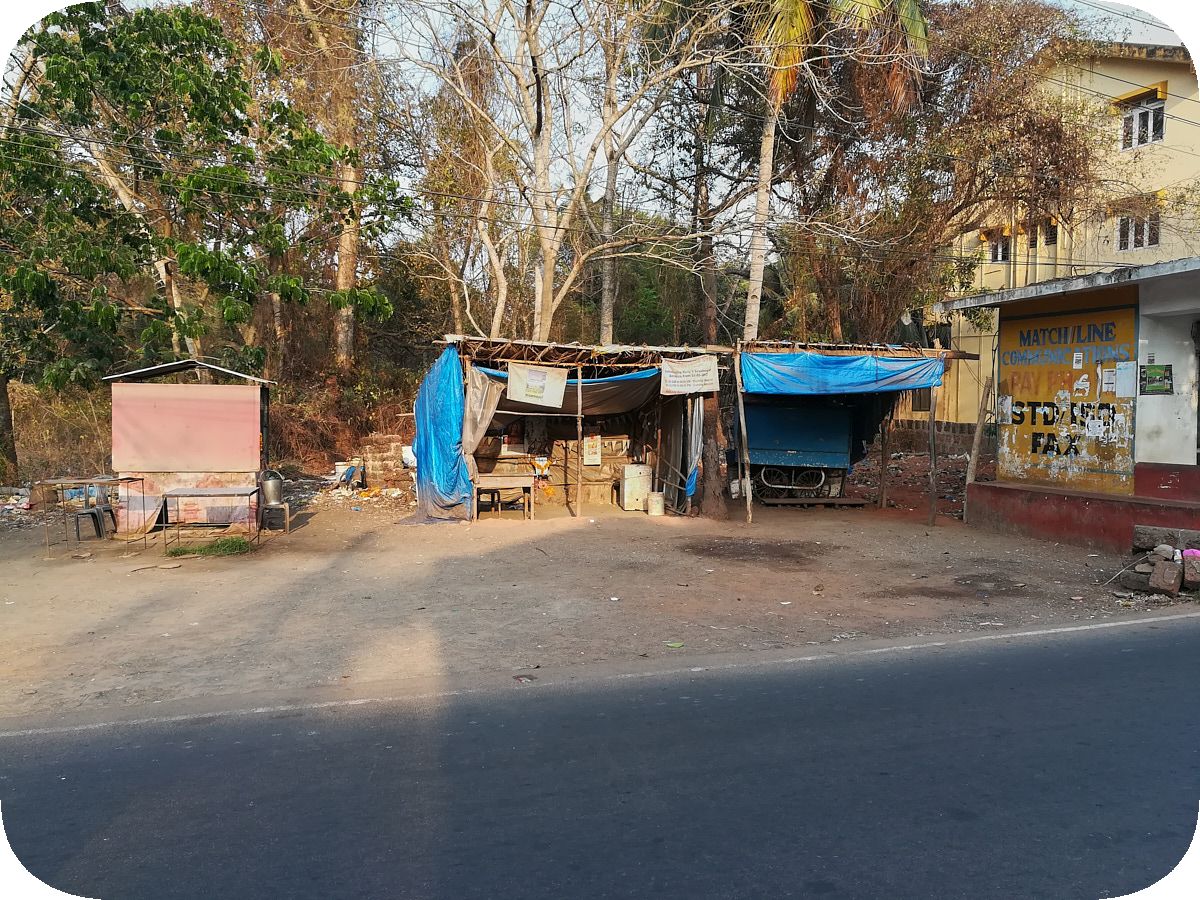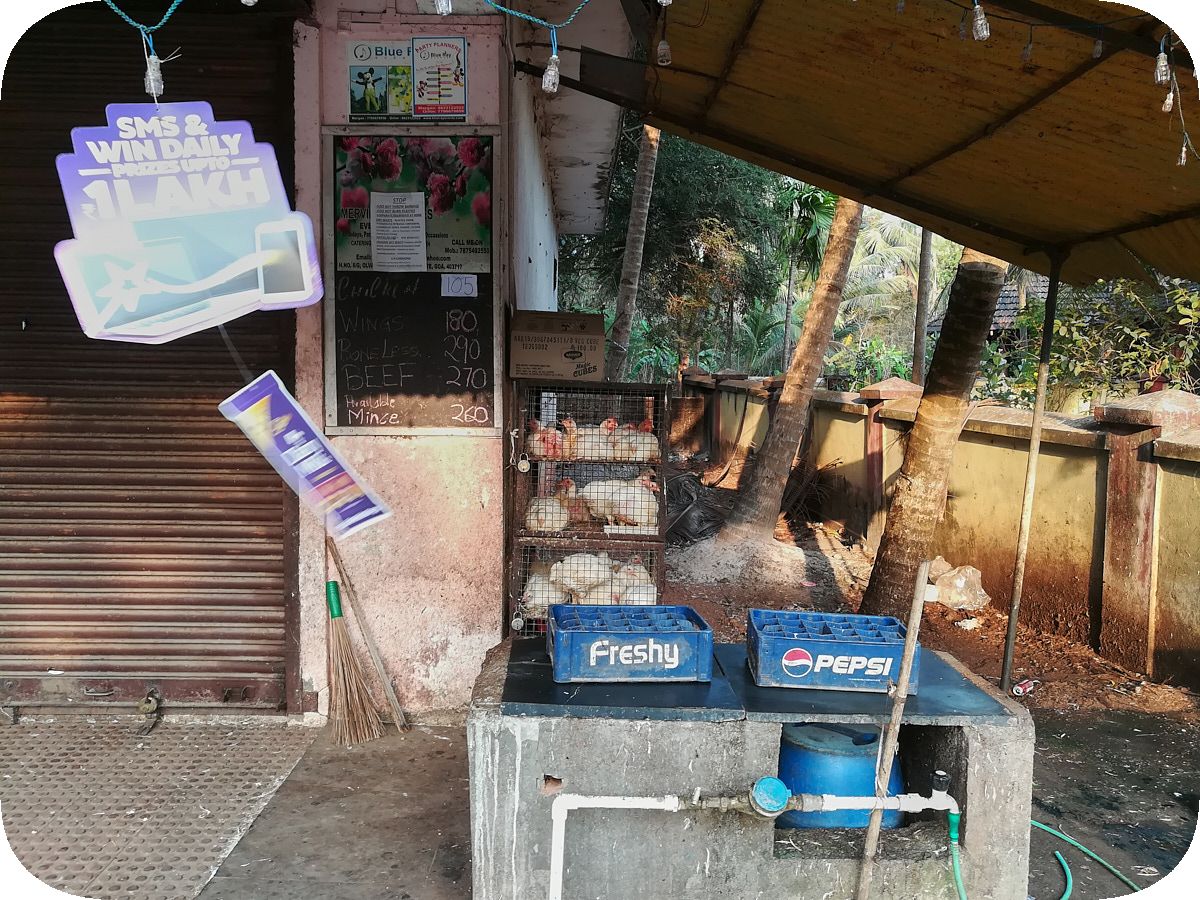HELLO,HIVE!
Okay, a little more about this “other” Indian world. It’s no secret that refrigerators are expensive and, moreover, they consume electricity, which for some reason you also have to pay for. In poor Indian villages, not everyone has a refrigerator, but people here eat not only rice, those who can afford it, eat meat too. There are no supermarkets here, but there is street trading. This green cage with a roof is on the street for a reason. Live chickens are sold here. There are a whole bunch of small shops in Goa, but you won’t find meat there. They sell groceries in jars and bottles and plastic packaging (plastic waste is India’s nightmare!), all kinds of chips, black tea, cookies, dairy and ice cream at most, sometimes vacuum-packed cheese sticks.

On another day, these departments were closed, and there was silence all around. We didn't pay much attention to the working hours of these meat departments, we didn't really need them. We didn't cook anything ourselves except for oatmeal for breakfast (breakfast at the hotel was included in the tour, but it was so "light" that a plate of bonus porridge never hurt), and used the services of inexpensive Indian cafes.

Here's another department with livestock. They sell chicken here alive, by weight. You buy a feathered bird, cut it up and... into soup. For a certain fee in rupees, they'll cut this chicken up for you and even mince it. Any whim for your rupees! Well, and judging by the price tag, they sell beef here. This is Goa, a former Portuguese colony, so Catholic traditions are still strong here, there are many Catholic schools. There are also Muslims, for them, too, a cow is just meat, there is nothing sacred about it. For many locals (not for all, there are Hindus here too) beef is just expensive meat. You can easily (though not everywhere) find beef dishes on the menu of beach cafes, we even once ordered beef in ginger sauce, it was cooked well, although I don’t like beef. Most often we ordered chicken or even meatless dishes in the spirit of “malai kofta”. Maybe it’s good that they didn’t cut up live chickens in front of us, we got such rather “vanilla” photos.

Well, and for us, loaded with papaya, tangerines and grapes, it’s time to go back to the room. We’ll hide the fruit in the refrigerator, because of the ants, and in the evening we’ll go to dinner, take some papaya with us and ask the waiter in some cafe to peel and cut it.
...to be continued...
●
Okay, ein bisschen mehr über diese „andere“ indische Welt. Es ist kein Geheimnis, dass Kühlschränke teuer sind und darüber hinaus Strom verbrauchen, für den man aus irgendeinem Grund auch bezahlen muss. In armen indischen Dörfern hat nicht jeder einen Kühlschrank, aber wer es sich leisten kann, isst auch Fleisch. Hier gibt es keine Supermärkte, aber es gibt Straßenhandel. Dieser grüne Käfig mit Dach steht nicht umsonst auf der Straße. Hier werden lebende Hühner verkauft. In Goa gibt es eine ganze Reihe kleiner Läden, aber Fleisch findet man dort nicht. Sie verkaufen Lebensmittel in Gläsern und Plastikverpackungen (Plastikmüll ist Indiens Albtraum!), Chips aller Art, schwarzen Tee, Kekse, Milch und höchstens Eis und manchmal auch Käsestangen im Vakuum.
An einem anderen Tag funktionierten diese Abteilungen nicht, es herrschte Stille. Wir haben uns nicht allzu sehr mit dem Arbeitsplan dieser Fleischabteilungen befasst; wir brauchten sie nicht wirklich. Wir selbst haben zum Frühstück nichts außer Haferflocken gekocht (das Frühstück im Hotel war in der Tour inbegriffen, aber es war so „leicht“, dass ein Teller Bonus-Porridge nie im Weg war), wir haben die Dienste preiswerter indischer Cafés in Anspruch genommen.
Hier ist ein weiterer Abschnitt mit Vieh. Hühnchen werden hier nach Gewicht lebend verkauft. Ich kaufte einen gefiederten Vogel, schnitt ihn in Stücke und ... in Suppe. Gegen eine Gebühr von Rupien wird dieses Huhn für Sie zerschnitten und sogar für Hackfleisch verwendet. Jede Laune für Ihre Rupien! Dem Preis nach zu urteilen, wird hier Rindfleisch verkauft. Dies ist Goa, eine ehemalige portugiesische Kolonie, daher sind die katholischen Traditionen hier immer noch stark, es gibt viele katholische Schulen. Es gibt auch Muslime, auch für sie ist eine Kuh nur Fleisch, es ist nichts Heiliges darin. Für viele Einheimische (nicht für alle, es gibt hier auch Hindus) ist Rindfleisch einfach teures Fleisch. Auf der Speisekarte von Strandcafés findet man leicht (wenn auch nicht überall) Gerichte mit Rindfleisch; wir hatten sogar einmal Rindfleisch in Ingwersauce, es war gut zubereitet, obwohl ich kein Rindfleisch mag. Am häufigsten bestellten wir Hühnchen oder sogar fleischlose Gerichte im Sinne von „Malai Kofta“. Vielleicht ist es gut, dass sie hier vor unseren Augen keine lebenden Hühner zerlegt haben; am Ende sind diese eher „vanillefarbenen“ Fotos entstanden.
Nun, es ist Zeit für uns, beladen mit Papaya, Mandarinen und Weintrauben, zurück in unser Zimmer zu gehen. Verstecken wir die Früchte im Kühlschrank, denn es gibt Ameisen, und abends gehen wir zum Abendessen, nehmen eine Papaya mit und bitten den Kellner in irgendeinem Café, sie zu schälen und zu schneiden.
...fortgesetzt werden...
●
